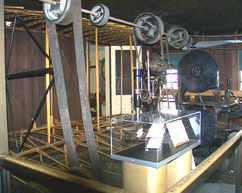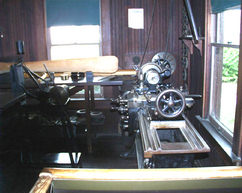|

 Up
Up 
 Will & Orv's
Will & Orv's
Workshop

(You are here.)
Return To
Kitty Hawk 
 Down
Down

Wind Tunnel
And Balance 
1902 Wright
Glider Model 



  Need
to Need
to
find your
bearings?
Try
these
navigation aids:
If this
is your first
visit, please stop by:
Something
to share?
Please:



|
|
Available in Française, Español, Português, Deutsch, Россию,
中文,
日本, and others.
 ilbur
and Orville always seemed to be building something. They were brought up to it by their
mother, Susan Koerner Wright. Her father, John Koerner, was a skilled
carriage maker
and taught his daughter to work with tools. She made many of her own home
appliances, as well as toys for her children. More important, she passed these skills
on to
her children. The Wright brothers built their first flying machine, a rubber band-powered
helicopter, when Orv was 8 years old and Will was 12. Later, Orville made kites and sold
them to his friends. Wilbur invented a machine that folded the United Brethren newspaper
his father published. Together they made furniture, printing presses, bicycles,
gliders, and airplanes. They also added a porch and a hand-carved staircase
to their home. Their lives seemed to revolve around their workshop. ilbur
and Orville always seemed to be building something. They were brought up to it by their
mother, Susan Koerner Wright. Her father, John Koerner, was a skilled
carriage maker
and taught his daughter to work with tools. She made many of her own home
appliances, as well as toys for her children. More important, she passed these skills
on to
her children. The Wright brothers built their first flying machine, a rubber band-powered
helicopter, when Orv was 8 years old and Will was 12. Later, Orville made kites and sold
them to his friends. Wilbur invented a machine that folded the United Brethren newspaper
his father published. Together they made furniture, printing presses, bicycles,
gliders, and airplanes. They also added a porch and a hand-carved staircase
to their home. Their lives seemed to revolve around their workshop.
It's no wonder that the Wright story seems to attract people who like to
work with their hands. Because of that, we created a "hands on" section where folks can
experience aviation history from the point of view of those who built it. In this virtual workshop,
we offer plans and information for airplanes and models you might like to build.
We'll also lead you through some aeronautical experiments and demonstrate
a few of the skills needed to build pioneer aircraft.
Here's what's
happening in our virtual workshop:
|


The workshop in which Will and Orv built their first airplanes now rests at the
Henry Ford Museum nearf Detroit, Michigan. |

